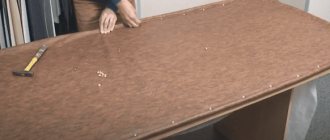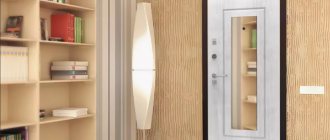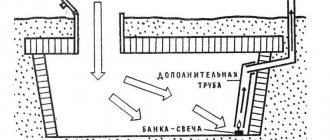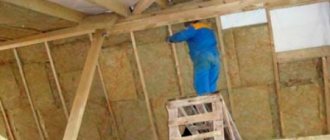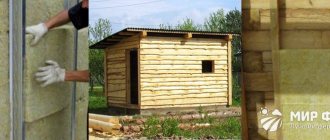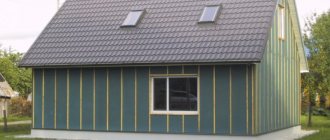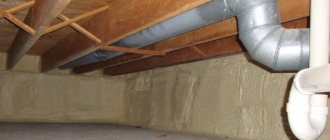The disadvantages of balcony blocks are the main ways of cold penetration into the premises in winter. This is especially felt if the loggia or balcony does not have external glazing or it is cold (made of sheet glass).
Rice. 1 Standard PVC balcony block
The most vulnerable area in the design of the block is the doors - they are often opened to access the balcony and sometimes for ventilation. Experts advise adjusting plastic windows and doors once a year - it is most practical to do this in the fall before the onset of cold weather, so that you can immediately insulate the balcony door with your own hands.
Reasons why cold gets into a room with a balcony block
A standard door to a balcony or loggia can be of two types: with full glazing and partial, when the panel at the bottom is covered with a plastic shield. A design with incomplete glazing is warmer - plastic has much lower thermal conductivity than window glass.
Before insulating the balcony door, you should identify the places through which the cold penetrates into the room. The main ways that cold air enters the apartment are places of defects or individual elements of the balcony block:
- Glazing for a balcony door. The lowest protection against cold is provided by ordinary sheet glass and large-area single-chamber double-glazed windows (fully glazed balcony door).
- Gaps between the canvas and the box. If the insulation loses its performance qualities, gaps may appear between the sheet and the frame, and cold air will enter the room.
- Loose fit of the door leaf to the frame. If the door has moved away from the frame, then a gap may appear in the hinge area that the seal cannot close - cold air will flow through it.
Rice. 2 Scheme of installation and thermal insulation of the balcony block - Poor quality assembly of the balcony block. Typically, a block for a balcony is assembled by connecting two parts - a window frame and a door frame. To do this, a sealing strip is laid between the walls to be connected or foam is applied to the surface, then both parts are connected with metal screws. If the seal was not applied or the screws came apart during installation, then cold air will penetrate into the gap between the frame of the door leaf and the window block.
- Poor quality installation of the balcony block in the opening. Sometimes it happens that for the sake of savings or a shortage of mounting foam, the balcony block is fixed in the opening not with a continuous strip of foam, but in separate sections. Also, polyurethane foam can decompose and crumble over time, and if the block was installed without a vapor barrier tape, cold will enter the room through the empty space. In this case, outside air enters the room through the gap between the external slope and the frame of the balcony block.
- Another reason for the penetration of cold air into the room is a violation of technology. The plastic frame has poor adhesion with cement mortars used for external slopes. When installed correctly, a pre-compressed self-expanding sealing tape (PSUL) is glued around the perimeter of the balcony block box from the outside, which seals the gap between the outer slope and the frame of the balcony block. In its absence, due to poor adhesion of the plastic with the cement surface, cold air will flow through the gap between the slope and the block box.
Rice. 3 Adjusting the web pressure and its distance from the box
Insulation of a wooden door
There are 2 ways to insulate wooden doors, each of which has its own pros and cons. The first method is more suitable for private houses whose doors face the street, while the second method is more convenient to insulate a wooden door in an apartment.
Method No. 1.
It is advisable to use this method for insulating wooden door panels up to 40 mm thick, otherwise the total thickness of the doors along with the finishing will be too large.
| Photo | Recommendations |
| Choice of insulation In this example, extruded polystyrene foam with a thickness of 20 mm was used, but with the same success you can install PSB-S25 foam with a similar thickness here.
| |
| Stuff the sheathing A lath with a thickness of 20 mm (according to the thickness of the insulation) and a width of 40 mm is used as lathing. The frame is mounted around the perimeter of the door leaf, plus 2 transverse horizontal strips are installed. As a result, 3 identical rectangular cells are installed on the doors. | |
| Lay the insulation The insulation slabs are cut precisely to the dimensions of the sheathing cells, and then they are laid inside the doors. It is not necessary to glue insulation here. | |
| Door paneling with boards For this particular panel, a 20 mm thick tongue-and-groove larch board was used. The paneling is done vertically, but this is not important; the board could just as easily be laid horizontally or diagonally. | |
| Clarifications and alternatives Clarification No. 1 Insulation with a thickness of 20 mm is not enough for severe frosts, but in combination with two layers of wood, the result is acceptable. Increasing the thickness of the insulation is risky, since the canvas already has a thickness of about 80 mm, which is the limit for wooden boxes. | |
| Clarification No. 2 Such an increase in the thickness of the canvas will require either reinstalling the locks or creating a recess in the casing for the keyhole. Plus, you will need to buy a longer core for the rotary handle. | |
| Clarification No. 3 Such massive doors will require canopies with appropriate load-bearing capacity. For example, the butterfly hinges shown in the photo on the left are designed for light or hollow door leaves; they are absolutely not suitable for reinforced doors. | |
| Alternative In the example described above, a 20 mm thick tongue-and-groove larch board was used. The product is of high quality, but quite expensive, so the price for a package of 5 two-meter slats is 1000 rubles, and for a door leaf you need 6 slats, which means you have to take 2 packages. Covering the doors with clapboard will cost much less. In addition to the reasonable price, the lining is also good because it is mounted on clamps and the attachment points are not visible, and the thickness of the planks starts from 12.5 mm. |
Do-it-yourself insulation of a wooden door video
Method No. 2
Now let's look at how to insulate a door using soft upholstery. There are also 2 options here, the easiest way is to buy a ready-made kit for door insulation. The standard set includes foam insulation and a medium quality faux leather pattern. Upholstery furniture nails are usually purchased separately.
For doors that do not claim to be exclusive, a ready-made kit for door insulation will be a convenient solution.
It is not necessary to buy a kit for door upholstery, all materials can be taken separately, choosing the appropriate quality and color, in particular you will need:
- artificial leather, material with good quality is called eco-leather, and consumer goods are still called dermantine;
- as insulation it is better to take foam rubber with a thickness of 20 - 30 mm, you can take batting, but it is not so elastic and is a little more difficult to work with;
- It is better to take furniture upholstery nails for future use, as you will need a lot of them.
| Photo | Recommendations |
| Nail the edge tape · Edge tape width 100 mm. · It is nailed along the edge of the canvas with an indentation of 10 - 15 mm. · At this stage, the tape is nailed with the wrong side facing up. · Near the corners, with an indentation of 10 - 15 mm, the tape is folded and fixed. · The entire perimeter of the doors is covered in this way. | |
| Nail the front panel Now you cover the upholstery leather with the right side up and with a slight fold, nail it along the edge of the doors only from the side of the awnings, and then fold the fabric to the side. The nails are placed on top of the edge strip, along the same row. | |
| Lay insulation Lay the foam rubber on top of the doors and cut it along the line of the nails.
| |
| Place for the lock If the lock is overhead, then a place for fastening is immediately prepared for it, as in the photo. Mortise lock covers can be mounted over upholstery. | |
| Stretch the upholstery Next, the foam insulation is covered with eco-leather. On one side the canvas is already nailed, now it needs to be slightly pulled up and nailed on the opposite side, after which the ends are also fixed. | |
| Trim the excess When the canvas is stretched and fixed, the excess edges of the artificial leather are trimmed at a distance of 10 - 15 mm from the edge. | |
| Roll the roller around the perimeter of the doors From the edge tape that was nailed at the beginning, you need to wrap a soft roller. To do this, foam rubber is placed in it and the tape is nailed along the perimeter of the doors. Next, the lock is attached and the door is hung on its hinges.
|
The option described above is closer to the budget one, but besides it there is also the so-called carriage screed - this is quilted upholstery made in the form of soft squares or rectangles. The carriage screed is mounted on a separate sheet of plywood, MDF or OSB, and then this trim is attached to the doors. It’s possible to arrange such beauty with your own hands; step-by-step instructions with photos and videos can be found “HERE” .
At the amateur level, arranging a panel with a carriage screed can take up to several days, but such beauty is worth the time spent
Methods for insulating a plastic balcony door
When deciding how to insulate a plastic balcony door, you should first pay attention to its adjustment. Plastic doors have a design that allows them to be adjusted for the purpose of insulation and replacement of individual elements; the list of main works is as follows:
- Strengthening the pressure of the door leaf to the frame. It is adjusted by eccentric bolts at the end of the door using a hex key inserted into the recess of the bolt head.
- Reducing the distance between the door leaf and the frame. This is done by turning the screw in the top hinge of the doors.
Rice. 4 Installation of a seal to insulate a wooden balcony door
- Replacing the seal. The seal may lose its elasticity and shape over time - in this case, it should be dismantled and a new one installed; replacement should be done on the door leaf and in the opening.
For installation, you should use door sealing tapes designed for the same type of profile. It is advisable to use a chamber type (their design provides a tighter fit than the petal type), the work is carried out in the following sequence:
- They dismantle the plastic balcony door by removing the decorative trim from the top hinge, after which they remove the pin from the hinge, pulling it down with pliers and tapping it with a hammer. Open the door slightly and remove it from the bottom hinge.
- Remove the old seal, moving the door fasteners aside with scissors, and install a new one in its place, gluing it at the top center.
- Do the same with the door frame seal - remove the old seal and replace it with a new one, gluing it at the top in the middle.
In order not to confuse the side of the tape during installation, you should remember the location of the old insulation or install the new one with the wider side outward.
Rice. 5 Insulating a balcony door by replacing double-glazed windows
- Replacement of glazing. The solution to the question of how to insulate a balcony door for winter may be to install energy-saving glass instead of regular glass. This is effective in casements with continuous glazing and can reduce heat loss several times. Low-E low-emissivity glass with magnetron sputtering of tiny particles of metals and oxides reflects heat back into the room; its installation in a single-chamber or double-glazed window increases its energy savings by 70%.
Heat savings are also provided by another type of energy-saving double-glazed windows - with argon between the chambers. Replacement of packages is carried out by simply removing the beads.
How to insulate different models of balcony doors?
Insulation of wooden doors can be done in the following ways.
Upholstery
- The insulation is prepared with your own hands from felt, cotton wool or tow.
- The material is stitched with a layer of rags.
- For insulation, upholstery is made of dark leatherette or oilcloth according to a pre-made pattern with an allowance of 1 cm on each side.
- The insulation is nailed down with small nails in a checkerboard pattern.
- To decorate the edges, special rollers are made. They are placed around the perimeter, except for the edge where there are loops.
- The ends of the insulation are wrapped to cover the rollers.
- Nail the upholstery with small nails. Then the surface looks aesthetically pleasing.
Additional glazing
Door leaves with glass inserts are often insulated using double-glazed windows. 3 glass can become an excellent insulation material. At the same time, the performance characteristics of the product are improved.
- Additional glass is installed on the inside of the frame.
- A sealant is glued to the fastening points.
- The cut glass is fixed with nails.
- To remove the gap between the frame and the glass, the gap is treated with putty.
- The glass is secured with glazing beads or special metal strips using special self-tapping screws.
The beads should be painted so that they do not stand out against the background of the frame. This option allows you to make high-quality thermal insulation of the upper part of the doors, which is glazed.
Sealant for plastic doors
Insulation of the space between doors
Thermal insulation between the inner door and the outer door allows you to reduce internal heat loss. The optimal material is polystyrene foam with a thickness equal to the distance between the two balcony doors.
- Insulation is cut out of polystyrene foam.
- The workpiece is installed in the opening.
Old newspapers can be used as free insulation for the space between doors. Every practical person can insulate a wooden balcony door in this way. Home craftsmen need practical tips on how to do budget thermal insulation with your own hands in order to make economical and high-quality insulation for the balcony door.
- Place 3 or 4 newspapers together, unfolded, to form rolls. Their diameter should slightly exceed the distance between the door openings.
- Tape the edge of each roll.
- Prepare the required number of rolls.
- Fill the inner space of the rolls with crumpled newspapers.
- Glue the rolls together to make one block.
- Install insulation.
To save material for insulation, use lining material from old outerwear: jackets and raincoats.
In this case, thermal insulation is performed on the lower part of the door leaf.
Using a refrigerator cabinet to insulate a balcony
Many people use the balcony as a kind of “storage room” where they store preparations for the winter. The balcony door can be considered as a place where you can install a refrigerator cabinet. This design will simultaneously perform 2 functions - to preserve marinades and canned foods, and to insulate the adjacent room from the cold that can penetrate the room from the balcony. For production, available materials are used - plywood, chipboard, beams. The cabinet is a mobile box with shelves. Then the owner of the apartment is provided with easy access to the balcony. One side of the cabinet should be open. It must be the same as the doorway.
- A refrigerator cabinet is made from scrap materials.
- Wheels are screwed onto the cabinet to make it mobile.
- The box is placed against the door with the open side.
- For decoration, wallpaper is used to cover the room.
Insulation of plastic doors
If there is a draft in the room, then the reason is that the device is loose and needs adjustment. When the sagging of the door is eliminated, and the cold from the balcony continues to penetrate into the home, it is necessary to check the rubber seal around the perimeter. If necessary, lubricate the tape. The free space can be filled with polystyrene foam, however, this material is difficult for people far from construction to work with. Therefore, it is easier to choose an easier and proven method.
Installation of thermal insulation is carried out by analogy with wood products. An insulated plastic door, covered with leatherette, prevents cold air from entering the house. The only difference is the use of construction adhesive instead of nails.
- Dismantle the door block.
- The fittings are removed, for example: a double-sided handle on the balcony door.
- Install insulation.
- Lubricate and replace all removed fittings.
- Make the decor.
If a gap has formed between the plastic slope and the wall, then it can be eliminated as follows:
- Unscrew the plastic slope.
- Seal the gap.
- Screw the slope into place.
To retain heat, you will also need to insulate the windows and walls. Today, many people install plastic balcony doors. It is recommended to choose burglary-resistant windows with double glass, since: the model can withstand increased loads; how to open a plastic window - a difficult task for burglars; The product effectively protects against drafts and adverse atmospheric conditions.
Source: misterdver.ru
Insulating a wooden door on a balcony
The insulation of a wooden balcony door is carried out by analogy with a plastic one - you can replace the insulation with a new one or the double-glazed window with a heat-resistant modification. If the door has a simple design with several handles and allows air from the street to pass through, you can increase the pressure by moving the linings in the box to fix the handles.
When deciding how to insulate a wooden balcony door or its plastic equivalent, you should keep in mind that the choice of methods is limited. You can change the seal and glass unit, carry out adjustment work - if the result is unsatisfactory, you will have to change the door or door frame profile along with the leaf.

